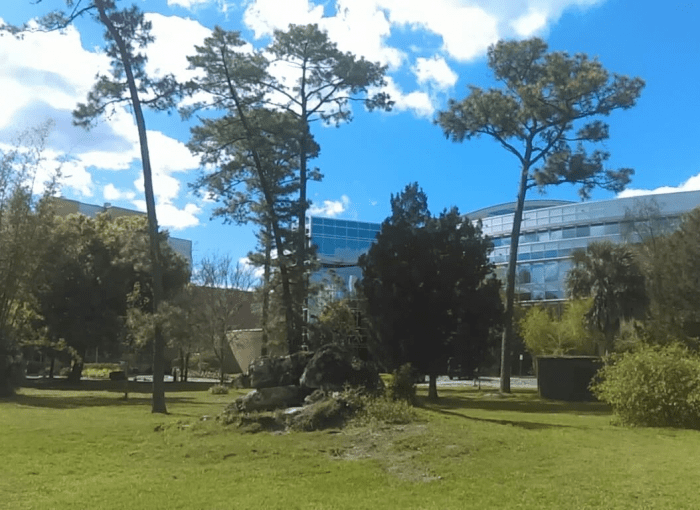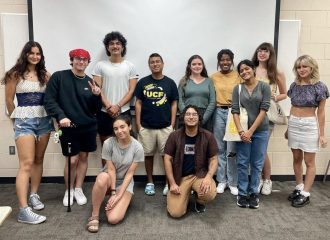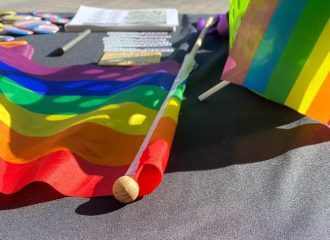by Winfield Pearson
In all of my three years at UCF, I have had at least one class a year in the Business Administration One building. Before and after those classes, I would spend hours studying on the patio tables and stone benches that line the paved paths from BA1 to the center of campus. During my downtime, I always noticed the four–story Harris Corporation Engineering Center, which I assumed was the very edge of all that was important and interesting in this part of campus, at least for an English major like myself. It wasn’t until this semester—my senior year—that I learned that there was a bonafide park lying just beyond where I had been spending most of my time on campus.
That park is UCF’s Arboretum, which is Latin for “tree-place.” Not only does the Arboretum give lots of roaming room for legs that need to stretch after a long shift at the computer lab, it also offers unique educational opportunities and services for students.
Finding the Arboretum
If you want to visit this hidden gem, head to the East side of campus, look for the Harris Corporation Engineering Building, and walk around to its back side. You have found your destination when you come across a solitary portable that has a built-in deck and trellis archway covered in twisting vines. It’s kind of like Hagrid’s hut that led Harry Potter to his school’s Forbidden Forest. This portable is adjacent to a large wooden sign that says: “Arboretum.” This is the main portion of the area, though there are actually miles of walking trails and natural lands around campus that make up the entirety UCF’s Arboretum.
The Main Plain
Just beyond the sign, you can freely walk right on to the grounds, exploring the place at your leisure. If you want to get familiar with the area before venturing out, verbal tours are available at the portable. On site, you’ll see a broad, stretching field with several tables to lay your laptops, and large shady trees to rest under. While much of the UCF campus is designed like a park, with walkways filled with foot and skateboard traffic that cut through grassy lawns, the Arboretum is much quieter and secluded from the campus hustle and bustle. Instead, everything just stays still there, because the Arboretum isn’t designed to be a between place, rather it’s “the place.”
Just to the right of this huge rock mound, is a stretch of natural land that lines an extensive creek. According to Arboretum Coordinator Kelsie Johnson, the rocks themselves are what remain of a former fountain that was re-purposed into the miniature “Pride Rock” we see today.
The flowing water to the far right of the entrance makes for a serene walking path that offers more than a few wiggling tadpoles to spy. Be forewarned that if you try to cross even the dry looking parts of this creek, you could find yourself shoe-deep in muck—and I speak from experience.
The Boardwalk Path
The creek-side path offers some nice recreational walking that leads to the boardwalk, which a classic staple of any Florida park landscape.
The boardwalk makes for a smooth stroll among the trees. Student artwork and self-expression is welcome on the boardwalk. At the moment, there is a slew of Beatles lyrics to offer some timeless wisdom and optimism to anyone’s day.
A Community of Gardeners
The boardwalk can take you right back to the community garden of the Arboretum, which is next to the creek. Kelsie Johnson informed me that at the community garden, student volunteers are invited to grow a variety of herbs, fruits, and vegetables that change by the season. Depending on the time of year, visitors can find collard greens, snap beans, squash, mint basil, oregano rosemary, mulberries, papaya, figs, and bananas. Mrs. Johnson also informed me that around 1,000 pounds of produce is grown here every year, then given away to Knights Pantry—a service that provides free food to students in need.
Near the community garden is the greenhouse, and you can’t miss it! Here, the ongoing projects and research work for botany and other science classes are stationed. You can also find the adjacent propagation house that is used to store larger plants, before they are ready to be planted outside in the Arboretum itself.
Bee Business
The Arboretum also has its very own apiary, which is a section of the grounds where bees are kept in box-like houses. According to Mrs. Johnson, the population of honey bees here continues to grow and thrive, with its first harvest producing 50-60 pounds of honey in its first harvest, and its second giving over 100 pounds. The nearby pollinator garden allows these bees to get all the pollen they need in order to make that delicious honey. If you are interested in the unique opportunity to work hands-on with these important members of the UCF campus, professor Patrick Bohlen offers a beekeeping class for credit during the Spring semester for around a dozen students.
What I Learned from My Short Trip
These are the features of the UCF Arboretum that I took in after only a short visit, so there is much more to explore. One thing I learned from my study break is that I tend to let myself fall into routines, where deviations are rarely allowed. Routines have a lot to do with where a person walks, almost as much as where they walk to. Allowing ourselves to go a little off course might seem inefficient, but it can lead to surprising discoveries—and what better time to make new discoveries than in college? So take a trip to any part of campus you haven’t been, especially when the stress of upcoming Webcourse assignments or studying for tests becomes too grueling. You’ll find that what you least expected has been there all along.
Laden with trees and harbored bees, near flowing streams, and wooden boardwalks, UCF’s Arboretum is a wonderous place to visit, full of educational opportunities and engulfed by nature. Visiting this vast area taught me an important lesson: Life will be full of routines, but the discovery of one’s favorite garden, nature preserve, mom and pop restaurant, or even best friend, is a meeting that can’t be scheduled. We ought to step out of our routines and wander off the path, where the old grey meets the new green.













